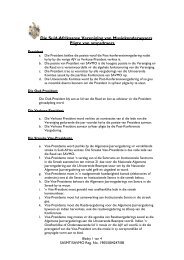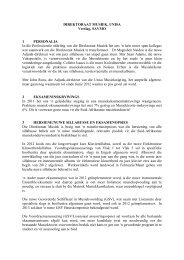2006 Edition 2 (Issue 144) - Sasmt-savmo.org.za
2006 Edition 2 (Issue 144) - Sasmt-savmo.org.za
2006 Edition 2 (Issue 144) - Sasmt-savmo.org.za
Create successful ePaper yourself
Turn your PDF publications into a flip-book with our unique Google optimized e-Paper software.
Jazz Improvisation 2<br />
•<br />
•<br />
•<br />
•<br />
•<br />
Locrian & locrian #2 scales<br />
Diminished scales —whole/half (mode 1), half/<br />
whole (mode 2)<br />
Whole-tone scales<br />
Diminished whole-tone: mode 7 of the melodic<br />
minor scale<br />
Multi-coloured one or two bar phrases, and with<br />
resolutions (ii-7 V7 I)<br />
Examination repertoire for Jazz Improvisation 2<br />
All Blues, All the Things You Are, A Night in Tunisia, Body<br />
and Soul, Confirmation, Four, I’ll Remember April, In a Sentimental<br />
Mood, Jordu, Oleo, On Green Dolphin Street, Ornithology,<br />
Peace, Star Eyes, What is This Thing Called Love?<br />
feedback<br />
During each exam the teacher is encouraged to make<br />
written comments to be returned to the students at the<br />
conclusion of the marking process or at the first class of<br />
the next semester. Students enjoy receiving comments<br />
or feedback in writing as encouragement to progress to<br />
the next musical level. Feedback helps them to understand<br />
what needs to be addressed and to comprehend<br />
the given mark. Comments from past panels have included<br />
the following.<br />
“Good time and feel.” This means that the assigned<br />
work was played in relation to the ground beat/pulse.<br />
To achieve this, students have generally practised the<br />
material with metronome or backing track and have<br />
listened to the jazz masters.<br />
“Very poor time” means that the melody, improvisation,<br />
lines, scales or technical material were not played in<br />
time or in relation to the ground beat/pulse. This is generally<br />
an indication that the student does not listen to<br />
the jazz masters or doesn’t practise or practises without<br />
a metronome or backing track.<br />
“Good, flowing phrases” generally translates to: ‘it<br />
swings’ or ‘it is in the groove’. This is a clear indication<br />
that the student has listened closely to the jazz masters,<br />
has practised the assigned work, and has a good internalized<br />
metronome and a developed sense of phrasing<br />
in the jazz style.<br />
“Stiff phrases.” The student plays the required material<br />
but doesn’t swing; usually an indication that the student<br />
practises but doesn’t listen to the jazz masters or<br />
perhaps listens primarily to Pop, Jazz-Rock and/or Fusion.<br />
“Head played well.” It is a musical joy to hear a melody<br />
(head) performed well. Experience has taught us that<br />
even well prepared students do not give the melody<br />
(head) the respect it richly deserves. I can’t stress enough<br />
the importance of having students learn and play the<br />
melody well from memory.<br />
“Learning scales, phrases or lines and technical material<br />
would improve your ability to play ideas convincingly<br />
and help you develop a jazz vocabulary and language.”<br />
An example of an<br />
examination mark sheet<br />
This is an indication that the student generally is not<br />
practising the assigned material.<br />
“8th-note lines are swinging.” Swinging eighth note lines<br />
are a central aspect of the jazz language. Like the importance<br />
of playing a melody well, 8th note lines played<br />
with good time and feel are found in all great solos by<br />
the jazz masters.<br />
guidelines and mark sheets<br />
Guidelines as recommended by the International Association<br />
for Jazz Education (IAJE)<br />
Improvisation: Evaluation is based on the soloist’s<br />
awareness of stylistic and harmonic content and the<br />
ability to communicate ideas to make creative, personal<br />
and musical statements.<br />
Style/interpretation: Evaluation is based on the soloist’s<br />
and the group’s awareness of a stylistically correct<br />
performance and interpretation of the chosen<br />
composition.<br />
Presentation: Evaluation is based on the appropriateness<br />
of the music in relation to the group’s or the<br />
soloist’s abilities and how the music is presented.<br />
Musicality: Evaluation is based on emotive communication<br />
— the extent to which technique is used to create a<br />
performance that is expressive and meaningful for performers<br />
and the audience.<br />
Time and rhythm: Evaluation is based on the performance<br />
of the tempo (beat) and the figures (rhythms) relative<br />
to one another and to the rhythmic concept of the<br />
compositions.<br />
Ensemble: Evaluation is based on the ability of the<br />
group to consistently perform the music in a fundamentally<br />
correct manner concerning aspects like phrasing,<br />
accents, dynamics and balance.<br />
Intonation: Evaluation is based on the ability to perform<br />
in tune, within and between sections.<br />
Technique/diction/articulation: Evaluation is based on<br />
the ability of the soloist and group to perform clean,<br />
clear and articulate musical phrases.<br />
continued on page 45...<br />
Suid-Afrikaanse Musiek Onderwyser |<strong>144</strong> | November <strong>2006</strong>




